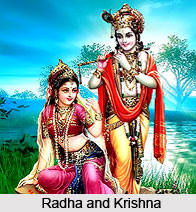 Krishna Gopala is a god of Hindus, who is worshipped across many traditions of Hinduism. His relation with the female deity Radha is very distinct in the history. Radha is always seen standing on his right side as his wife or consort.
Krishna Gopala is a god of Hindus, who is worshipped across many traditions of Hinduism. His relation with the female deity Radha is very distinct in the history. Radha is always seen standing on his right side as his wife or consort.
Krishna Gopala was considered as the male god and the goddesses Radha is envisaged as the epithet of the god`s power or energy, his iakti. The male god is conceived as the supreme lord and master of the universe or as the Adorable One. Again, Radha, his spouse is identified with the great cosmic sakti, the force or energy that sets the universe in motion.
The great goddess Devi is identified with prakrti, nature, as in the Samkhya system of philosophy or with yogamaya, the power of illusion responsible for the emanation and development of the visible universe. This energy is embodied as the great goddess, Devi and she is worshipped by gods and humans under a variety of names as the mother of the universe (jagddamba). It is believed that the great Goddess ultimately controls even the supreme male deity whose production she is supposed to be.
Thomas Coburn has rightly said, `although Devi is understood to bear a unique relation to each particular deity, this is no `mere` consort relation, she is beyond being a consort to anyone. So, whenever the Radha-Krishna couple is discussed, this point is to be kept in mind. Radha herself is said to be in eternal union with Krishna and is worshipped as his hiadial-sakti, his power.
The problem of Radha has been much discussed in various articles. In various Indian literatures Radha is discussed frequently from the time of Hala. The emergence of Radha in the cultic and devotional sphere of Vaisnavism as Krishna Gopala`s beloved and Shakti is said to have taken place rather late. It is traced back certainly not much earlier than the sixteenth century.
Radha is well known for her total absorption in her love for Krishna otherwise she was an obscure cowherd girl having a humble origin. Radha was somewhat ill-fitted to take the place of the mother of the universe.




















